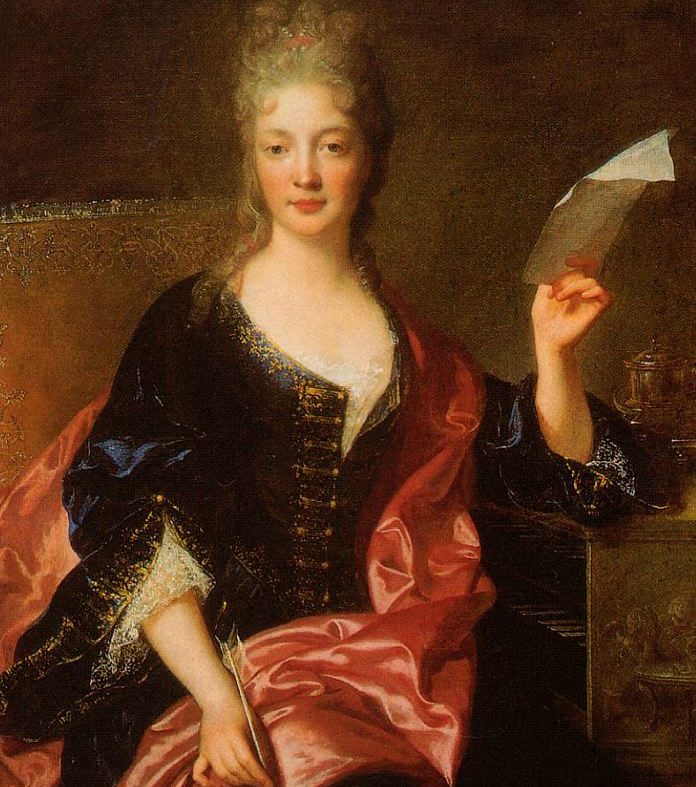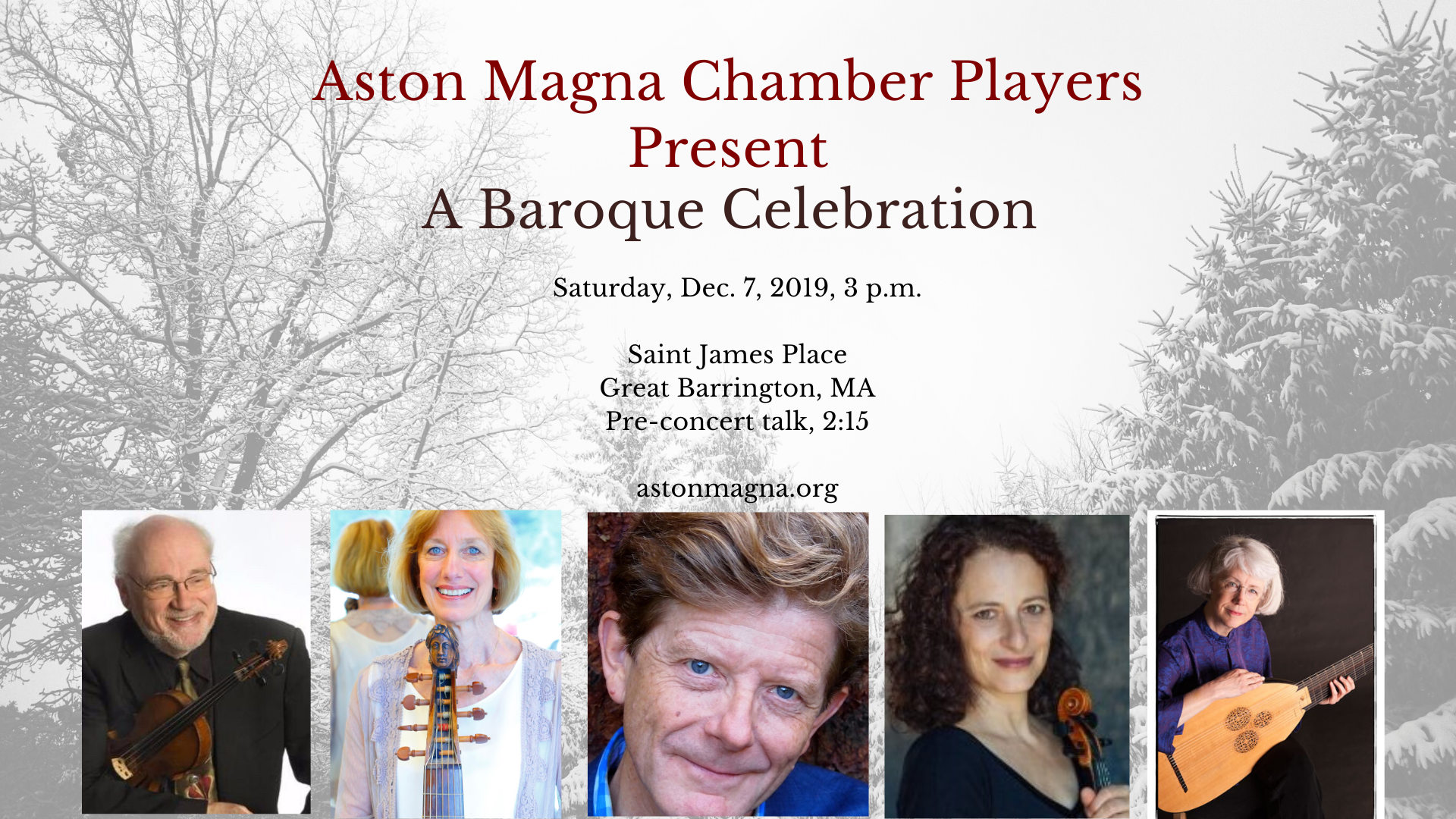Kristen Watson, soprano ~ Deborah Rentz Moore, mezzo soprano
Jason McStoots, tenor ~ David McFerrin, baritone
Daniel Stepner and Julie Leven, baroque violins; Laura Jeppesen, viola da gamba ~ Catherine Liddell, theorbo; Michael Sponseller, harpsichord
Sonata V, from Sonatas in Four parts
Purcell on the Vicissitudes of Love:
Dialogue between Coridon and Mopsa (from The Fairy Queen)
“You say ‘tis Love” (from King Arthur)
“To bless the genial bed” (from The Indian Queen)
Dance of the Haymakers (instrumental, from The Fairy Queen)
“The joys of wedlock soon are past…” (from The Indian Queen)
Final scenes from Dido and Aeneas
“The joys of wedlock soon are past, but I, if I please, can make ‘em last”
(from The Indian Queen)
“Bane of passion, pleasure’s curse….” (from The Indian Queen)
“Since times are so bad…” (from Don Quixote)
Intermission
Suite in F major, Z. 669
Prelude
Almand
Corant
Round O (ZT. 684)
Sleep aids (from The Fairy Queen)
Night: “See even night”
Mystery: “I am come to lock all fast”
Secresy: “One charming night”
Sleep: “Hush, no more”
A celebration of the seasons (from The Fairy Queen)
“When a long cruel winter”
“Hail, Great Parent”
“Thus the ever grateful spring”
“Here’s the summer”
“See, see my many coloured fields”
“Next, winter comes slowly”
“Hail, Great Parent”
“Now the Night is chas’d away” (from The Fairy Queen)
NOTES ON THE PROGRAM
Henry Purcell came from a family of musicians and court officials that flourished in the late 17th and early 18th centuries. While he lived through a particularly contentious time in English politics, he emerged as one of England’s greatest composers. His music has an immediate appeal while also being full of inventiveness. This program is devoted to excerpts from his stage works, all of which were written in the last five years of his life. The fairy-queen, Z.269 will receive particular attention.
The opening work for this evening’s concert, functioning as a sort of overture, comes from Ten sonatas in four parts, for two violins, bass viol, and basso continuo. The works were likely assembled over a long period of time, beginning in 1678 and ending in 1684, but were only published two years after Purcell’s death. There is another set of sonatas in three parts, from 1683, but with exactly the same scoring. The preface to this earlier collection indicated that Purcell, “faithfully endeavour’d a just imitation of the most fam’d Italian Masters”. By this remark he was apparently not referring to his contemporaries, such as Arcangelo Corelli, but to a previous generation, such as Giovanni Legrenzi or Giovanni Battista Vitali. In Purcell’s sonatas the bass line is a near equivalent to the two upper voices, and dance-like movements are freely intermixed with more abstract forms, which became increasingly rare in the Italian school. Also the movements are linked, while Corelli’s movements were discreet.
The next group of pieces are excerpts from Purcell’s stage works, organized around the theme of how hard love can be. Opera in London in the late 17th century was a non-starter. In the dramatic arts, there was clearly a preference for spoken plays, and the addition of music appreciated, but in limited amounts. These musical insertions into the drama typically took the form of “masques”, which was an English version of sung drama, but could include, by the late 17th century, dances and fantastic scenes. The result was a hybrid form of entertainment, inheriting from the masque the sung recitatives, the dances and the use of “machines” in the form of clouds, flying figures, etc., suspended by ropes, or scenery with mechanical action, generally on rolling wheels.
Purcell’s involvement with the theater came relatively late in his career. Though he had written numbers for other stage works, there are no such works by him before 1689 (or possibly earlier), when Dido and Aeneas, Z.626 premiered to a private audience. Yet about this time, due to the emergence of the Dorset Garden’s Theatre (or Queen’s Theatre), spectacular performances became possible in London, and Purcell responded with some of his most beautiful music.
We begin with an excerpt from Act III of The fairy-queen, written in 1692 and revised the following year. The work uses an anonymous libretto based on William Shakespeare’s A midsummer night’s dream, though Purcell did not set a single line of the playwright’s original drama. In Purcell’s original version, the first act follows Shakespeare very closely, but in the 1693 revision more music is added for the entertainment of Titania’s Indian Boy. The masque in Act III is ordered by Titania for her new lover, Bottom (with the head of an ass). The down-to-earth banter of Coridon and Mopsa is a response to the wondrous transformations that dominate the first half of the act. Originally for soprano and bass, it was rewritten for countertenor and bass for the revival, perhaps giving “No, no..no kissing at all” more comic effect.
King Arthur, or The British worthy, Z.628, appeared in May 1691 and is based on a text by John Dryden that was written to be set to music. The work is rich in effective musical content. “You say ‘tis Love”, with a text written by “Mr. Howe”, comes near the end of the work as part of a masque celebrating a military victory of the King’s. It features a pair of lovers, called “He” and “She”, philosophizing on the pain Love brings.
The Indian queen, Z.630 is an exotic work, taking place in the Americas. It was not completed by Henry Purcell, but by Daniel Purcell (ca.1664-1717), who was either a brother or cousin to the composer. Daniel provided a triumphal conclusion to the work, a masque that included a scene in which Hymen, the Greek god of marriage, encourages a doubtful married couple. A brief dance from The fairy-queen, featuring the couple from the opening number is inserted into this evening’s order, followed by Cupid’s attempt to extend the joys of marriage.
The mood shifts to make way for a deeply vexed lover, Dido, the Queen of Carthage, moving us from the comic and lyric to the tragic. She has been undone by a Sorceress and her witches, who have tricked Dido’s lover Aeneas into abandoning her. He has come to announce his intentions to leave Carthage. They fight bitterly, and he parts. Following a brief chorus and a recitative, she sings the well-known “When I am laid in earth”. This is a brilliantly constructed scene. Through the repeated chromatic falling bass line, the frustrated cadences, and the mournful “Remember me”, Dido’s decline is palpable.
A recap of Cupid’s number is rebuked by “Two married people”, who convey their unhappiness.with marriage in “Bane of passion”. Finally, from Act IV, Scene 3 of The comical history of Don Quixote, II, Z.678/6-8, a “Clown” and his wife deliver an extended, healthy conversation about the husband’s possible career moves. But she will have none of it, shrewdly and quickly pointing out the flaw in each suggestion. Wisdom triumphs, and the two finish of one mind.
The second half is almost entirely dedicated to excerpts from The fairy-queen, but begins with three movements from a keyboard suite in F major, Z.699, a prelude and two dance movements, “Almand” and “Corant”. The latter are singularly elegant, in a French sort of way. The tripping effect in the “Almand” is a particularly lovely touch. For a final movement, the soloist will play what should be a familiar tune. The keyboard version of Round O is an arrangement of a rondo movement from yet another stage work, Abdelazer, or The moor’s revenge, Z.590, which appeared in Purcell’s final year. Benjamin Britten made this tune very famous, exploiting it magnificently in his Young person’s guide to the orchestra.
The next set of excerpts from Act II of The fairy-queen presents a series of very effective moments. They follow the scene wherein Oberon dispatches Puck to apply the magical herb that will send the lovers into confusion. The music begins with Titania dancing with her fairies, but the festivities are interrupted by a series of solo numbers in which the Queen is lulled to sleep by Oberon’s magic. In the Masque of Sleep, each of the topics—night, mystery, secrecy, sleep—is represented by a different singer, and the narcotic effect intensifies with each character. Each identifies their role in the magic. Night begins with a fugue in which the four entries of the subject are heard, and more entries after the voice begins. But the contrapuntal accompaniment has little to do with the independent voice part. Secrisy prizes pleasure, and all of it lies in the vocal line over a dry accompaniment. But it is Sleep’s soliloquy with its long moments of soundlessness, echoed by a chorus that might put us all down.
Another quartet of characters makes an appearance in Act IV, in what is called the Masque of the Four Seasons. They are introduced by the god Phoebus, who announces the coming of Spring (which he [ahem] brought about). Following a chorus of praise to Phoebus, each season describes itself and its gifts. For certain, Spring and Summer are bright and cheerful, while Autumn and Winter are much less so. Mirroring what was sung by Sleep, this setting is also very heavy. Fortunately, before we all freeze, a recap of the chorus of praise breaks in to end the set.
Backing up just a bit, the program closes with the number that began this musical portion of Fairy-queen. Featuring solo soprano and chorus over a ground bass, the crew gleefully celebrates the birthday of Oberon.
~Joseph Orchard © 2019




